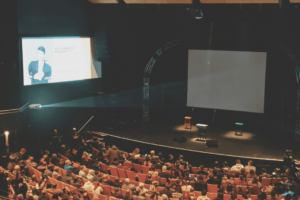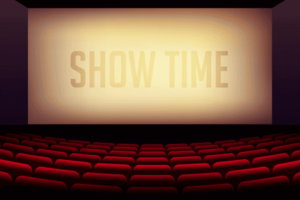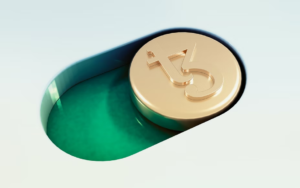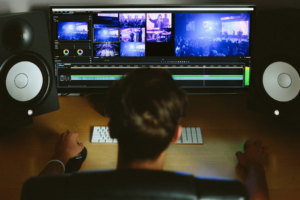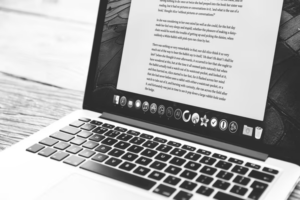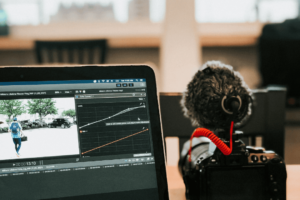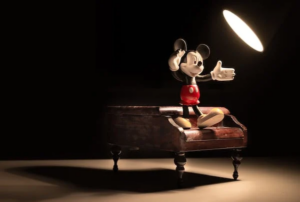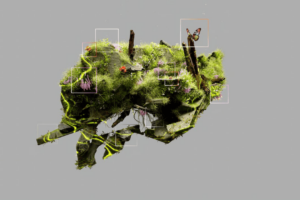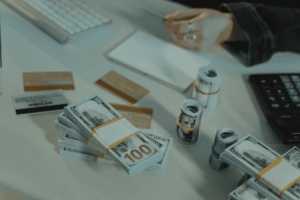Sound design is the art of creating the audio for film, television, advertising, music, and other productions. This broad field involves:
- Creative recording
- Mixing
- Sampling
- Sound editing
- Tweaking effects chains
- Film scoring
Productions typically use these five sound design elements:
- Ambiance is the background noise that sets a scene. It should be appropriate and informative without overwhelming the recording’s focus.
- Foley sounds are the sounds of actions that make scenes seem more real. Ex: footstep sounds or material moving as someone walks
- Audio effects are sounds created because they don’t exist in the real world. Ex: an alien invasion.
- A voice-over is the voice of a narrator who is either a character or an unseen narrator driving a story forward.
- Music includes songs and instrumental pieces that influence mood and help tell the story.
The History of Sound Design
Sound has been used in theater for centuries, but the role of a sound designer originated about 50 years ago with the rise of audio and recording technology to produce sounds for film and TV.
The Business of Being a Sound Designer
Most sound designers are self-employed and may work for several businesses each year. Directors, producers, and venues headhunt the best sound designers.
The sound design process has three key steps:
1. Live Recording and Design
During this initial step, sound designers may record sounds, use sounds from a sound library, or create original sounds.
2. Mixing, Editing, and Implementation
Next, sound designers edit and synchronize their sounds with videos. They cut and mix sounds to make them more effective, then use sound engines to implement them.
3. Sound Effects Mix
Sound designers often add sound effects to main sound mixes.
Sound Design for Film and Television
Sound design helps bring film and television productions to life. It involves:
- Dialogue capture
- Sound editing and mixing
- Foley
- Musical soundtracks
Sound Design in Music
Sound designers also help musical artists realize their creative visions by manipulating the raw sounds of vocals and instruments to make them sound their best. This process involves:
- Sampling
- Digital sound creation
- Ordering effects in a vocal chain
- Sound editing and mixing
The Differences Between Sound Design and Music Production
Sound design and music production can be part of the same project but they are different creative processes. Sound design builds sounds and effects from scratch, while music production creates songs and soundtracks.
Other Members of the Creative Team
Sound designers work closely with some of these creative professionals:
- Directors
- Producers
- Composers
- Music supervisors
- Lighting designers
- Sound and audio editors
- Sound effects designers
- Foley artists
- Audio recording engineers
The Sound Designer’s Work During the Production Process
The sound designers are a vital part of any film or television production. Their work begins in pre-production and runs to the end of post-production.
Pre-Production
During pre-production, the sound design manager studies a script with the director to determine vital sounds and music. Some directors have clear expectations about how their projects will sound, while others are more open to collaboration. The sound design manager may attend rehearsals to help them develop an appropriate soundtrack.
The sound design team is given a budget and allocates it for the following:
- Sound production crew
- Recording studios and other shooting locations
- Talent
- Music licensing
- Voice-over recording
- Sound editing and mixing
- Catering
Production
During production, the sound design team is responsible for:
- Setting up sound playback equipment
- Training the soundboard operator if required
Post-Production
During post-production, the sound design team refines the audio and ensures it sounds its best by:
- Working with audio files that correspond to visuals
- Placing dialogue and music on the timeline of video editing software
- Designing audio
- Adding dialogue, music, and voice-overs to designed audio
- Ensuring audio syncs correctly with the visuals
How Do I Become a Sound Designer?
A combination of education and on-the-job training helps sound designers succeed.
1. Formal Institutional Training
Sound designers do not require degrees. However, formal training through a theater or film school can be beneficial. Schools often have strong relationships with organizations employing sound designers, so they can help students make valuable career contacts.
2. Apprenticeship, On-the-Job Training (OJT), and Work-Study
Apprenticeships, on-the-job training, and work-study programs with small theater and film companies give aspiring sound designers practical experience.
3. Develop Your Vision
Developing your vision, and knowing what you want to achieve will help you attain your goals.
Tips for Becoming a Sound Designer and Getting Out There
After completing your education and training, use the following strategies to kickstart your career:
- Join online sound design communities
- Ask family members and friends if they know anyone needing sound design work
- Create a sound library to make yourself more appealing to potential clients
- Listen to a variety of music recordings, sound designs, and film scores
- Accept small projects to build your resume
- Work as a freelancer on various projects to diversify your skills
- Be patient and understand that it takes time and experience to secure your dream projects
The Market for Sound Design
The sound design market is expanding with more companies requiring content for apps, websites, and advertisements in addition to traditional film and TV productions.
Designing Audio
Sound designers take the audio captured during filming and manipulate it to sound better. Dialogue, for example, is regularly refined in post-production. Substituting original dialogue with newly designed audio is called automatic dialogue replacement, which involves:
- Removing background noise and imperfections from recorded dialogue
- Muting edited dialogue
- Designing the environment
- Designing sound effects
Designing audio falls into two main categories: creative and real sound design.
Creative Sound Design
Creative sound design is the creation of sounds outside reality like sounds of aliens or monsters. These are created by:
- Making sounds with ordinary items such as cutlery and metal bins
- Manipulating recorded sounds
- Creating sounds with digital tools such as oscillators and filters
- Layering different sounds on top of one another
Real Sound Design
Real sound design is the creation of sounds replicating those heard in reality. These sounds are created by:
- Making sounds in a way they would occur in real life
- Using unrelated tools to create sounds mimicking real life
They are then treated to sound right for their environment. For example, footsteps in a carpeted room sound different from those in a tiled room.
Sound Design Tools and Techniques
Sound designers have a range of tools and techniques that help them efficiently manipulate and create professional sounds. Some of these include:
Effects
Sound designers use audio effects to enhance ordinary sounds, including:
- Changing the order of effects
- Routing effects in various ways
- Layering different effects
Experimental Recording Techniques
Experimental recording techniques are innovative tactics for altering original sounds that include:
- Using signal chains
- Using different microphones
- Positioning microphones in different locations
Create With Your DAW and the Plug-Ins You Already Have
Your digital audio workstation (DAW) allows you to:
- Change audio speed
- Change playback direction
DAWs come preloaded with several plug-ins. Modulation, panning, and volume automation tools can transform your sounds.
Sampling
Sampling involves including audio from other sources in a recording. Hip-hop music often samples by:
- Using in-built synthesis tools such as filters and envelope generators
- Changing factors including the decay, attack, sustain, and release
- Creating original samples
- Adding a transient sound, such as extra drums
Synthesis
Synthesis is creating new sounds from scratch using your own parameters. These tools can influence the way synthesized audio sounds:
- Oscillators
- Filters
- Envelope generators
MIDI
MIDI can also help sound designers control different features of sound recordings. MIDI makes experimenting with the following sound elements easy:
- MIDI effects, such as arpeggiation
- Note patterns
- Control change messages
Field Recording/Found Sound
Field recording is collecting sounds, called found sounds, from anywhere outside and bringing them back into the studio.
Sidechaining
Sidechaining is a technique where an effect activates an audio track to balance it out and provide more clarity.
Record Everything
The best sound designers know sometimes their best work happens by accident. Recording everything with an external wave editor preserves any accidental strokes of genius.
Reverse It
Reversing sounds via sampling or manipulating the DAW timeline can give them a new complexion. Sound designers might reverse the following sounds:
- Leads
- Vocals
- Drums and basses
- Pads
- Effects
EQ as a Creative Filter
Equalizers, or EQs, can be used to enhance sound by improving its levels and creating dramatic effects.
Plugin Orders
Sound designers can also create dazzling effects by varying the order of their plugins.
Save Your FX Chains
When you make an effects (FX) chain you like, save it to use it again in the right situation, without loading the plugins individually. The DAW makes saving FX chains easy.
Use the Wrong Plugins
Sometimes the wrong plugin can be so right. Using a vocoder on a guitar riff or a vocal enhancer on drums can create unusual and exciting sounds.
Distortion and Noise
Distortion and noise may seem undesirable, but they can be striking when used in the right way. Pre- and post-filtering can amplify or dilute these elements, depending on the desired sound.
Patch cloning
Patch cloning helps sound designers understand how each change they make impacts sound. Simply open two instances of a plugin, initialize one and load a preferred preset into the other. Then match the parameters on the initialized synth to the patched one.
Bitcrush Excitement
Bitcrushing creates striking sound effects that can add interest to a sound or create intense sound variations.
Mash Up Your Existing Parts
Combining different audio sections by manipulating them, changing their order, and layering them can create exciting effects.
Auxome
Auxome, or auxiliary return tracks, can make sounds seem fuller. Equalizing and processing auxiliary return tracks separately helps sound designers control their products.
Layering Textures
Layering sonic textures, like adding a grainy field recording, can create new sounds and make a clean piece of studio-record music feel edgier.
Extreme Time Stretching
Extreme time stretching techniques can create unusual and engaging sounds.
Separate Sessions
Sound design can be laborious, so most people use separate sessions, then piece them together seamlessly.
Sound design is a vital area of film and television that can provide a rewarding career for creative minds.
